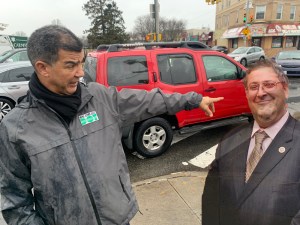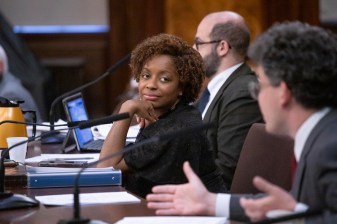City Council Singles Out Bike Lanes in Bills to Codify DOT Outreach

The City Council Transportation Committee held hearings on three bills today, each of which would add more requirements to the Department of Transportation’s review process for street redesigns, especially bike lanes.
For the most part, the bills codify what DOT already does: present bike projects to community boards, coordinate with other agencies before implementation, and report back on the results.
Intro 412, sponsored by Lew Fidler, would require community board hearings on all bike lanes at least 90 days before construction. (An existing law already mandates CB hearings prior to the installation of most bike lanes.) Intros 626 and 671, both sponsored by committee chair James Vacca, would require DOT to consult with other city agencies before undertaking a major transportation project and mandate the release of safety and traffic speed data for those projects. Each of the three bills would amend Local Law 90, which the council passed at the end of 2009, requiring DOT to go to community boards for all projects that add or remove a travel or parking lane for more than four blocks.
DOT only opposed one of the bills. “We agree with the idea behind Intro 671,” said Deputy Commissioner for External Affairs David Woloch, “but we also believe that since each project DOT conducts is unique, it requires a customized data collection plan.” Woloch said that Gale Brewer’s Local Law 23 of 2008, which created the agency’s Sustainable Streets Index, was preferable in that it maintained the needed flexibility of measurement. During the hearing, Vacca did not spend significant time discussing this bill or pushing back on DOT; he focused on the other two pieces of legislation instead.
The other two bills merely codify existing department practices, Woloch said, adding that DOT already goes to community boards for all bike lane projects, as Fidler’s bill would require. “This process has been successful in gaining community understanding and support for bicycle lane projects,” he said. DOT also already consults with NYPD and FDNY on all street redesigns and works with the Department of Small Business Services and Mayor’s Office for People With Disabilities on more general policy issues. While Woloch said that DOT would need to see some minor changes to the bills’ language — changing the wording to clarify that community boards would hold hearings over bike lanes, not DOT itself, for example — the department was on board with the basic concepts.
That made for a conciliatory hearing while DOT’s reps were testifying. “I’m thrilled that the commissioner is behind it, because I think she gets it,” said Fidler of his bill. He also said that he could tell DOT’s public outreach had significantly improved. “There’s been a notable difference in DOT’s outreach, at least in my community, in the last few years.” While he carped about “bike lanes dropped from the sky,” Fidler also said that he expected his bill to constrain future administrations more than this one, which was already complying with its rules.
Transportation Alternatives came out strongly against Fidler’s bill, saying that it would add unnecessary red tape to nuts-and-bolts safety improvements. With Local Law 90 on the books, the Fidler bill would only cover the smallest bike projects, which shouldn’t require additional oversight unless community boards or the DOT want it, he said. Currently, the law already requires DOT to get community board input on projects that take away or add a travel lane or parking lane for four blocks or more.
“We’re talking about the most minor, the most routine bike lanes that DOT paints,” said TA general counsel Juan Martinez. “When we’re talking about these routine improvements, the months of delay that happen when you have to go through the community board means New Yorkers’ safety is delayed.”
When Vacca responded, he didn’t acknowledge that Martinez had suggested community boards retain the option to comment on a project, if they want to. “You disagree with their right to have input?” Vacca shot back. “Maybe you consider it mundane, but maybe people in that community consider it important. That’s patronizing and unacceptable.”
Martinez also pointed out that only bike lanes were covered under the Fidler bill. “This bill doesn’t ask for more community input over crosswalks or to add more parking.”
Fidler seemed to acknowledge that public review could grow excessively burdensome. If you went to the community board for every transportation project, he responded, “government would be paralyzed.” But he insisted that even the smallest bike projects — even sharrows — need this level of scrutiny because they’re extremely controversial. Fidler also reiterated his ostensible commitment to building bike lanes — “we need to have safe and complete streets,” he said — and suggested that while he’d opposed proposed lanes in his district, bike infrastructure that brought people to the subway or to parks would be a better fit.
Whether Fidler’s singling out of bike lanes was meant to throw a wrench into efforts to build more bike infrastructure or not, anti-bike activists showed up to support the bill. Jack Brown, the founder of the Coalition Against Rogue Riding, never once mentioned community boards or public planning in his statement in support of Intro 412. He did, however, refer to “bike bedlam,” “a public safety crisis,” and — not once, but twice — compared cyclists to terrorists.
Representatives from community boards who attended the hearing each testified that DOT’s public outreach process is not only adequate but commendable. “My experience is that DOT adheres to the letter and spirit of the law” requiring community input, said Ian Dutton, the former vice-chair of Manhattan Community Board 2’s transportation committee. “I can say categorically that DOT has not installed a single bicycle infrastructure project without the input of CB 2.”
Wally Rubin, the district manager for Manhattan Community Board 5, said he’d seen a lot of DOT as they installed bike lanes and pedestrian plazas through Midtown. “With each of these efforts, they have reached out to us, the BIDs, and the larger community,” he said. “They have listened to us and more than once gone back to the drawing board.” Projects that began as extremely controversial, like the redesign of traffic around Union Square, were explained and revised until the community got on board; they ended up as major successes once complete, said Rubin. “We only wish that other city agencies would be as responsive and interested in our input as DOT.”

